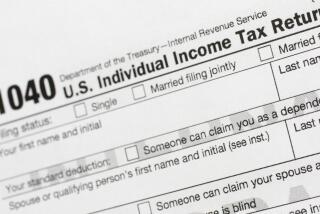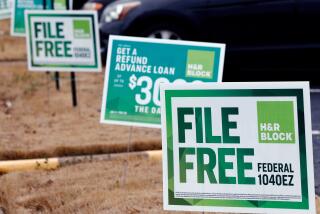IRS Pampers, Guards ‘Martinburg Monster’ : Tax Data: The tax returns of more than 190 million taxpayers and businesses are stored here. Its magnetic tapes could circle the Earth 5 1/2 times.
- Share via
MARTINSBURG, W.Va. — The heart of the Internal Revenue Service doesn’t beat. It whirls, beeps and blinks at dizzying speeds on dozens of computers and about 330,000 spools of computer tape guarded like a fortress.
It has your number.
“This is the one place where it all comes together and where it all goes back out,” says Gerald Rabe, director of the Martinsburg Computing Center, dubbed “The Martinsburg Monster.”
“I would say the computer system we use here is probably second to none in the amount of data processed.”
Row upon row of blue-and-tan computers hum inside a single-story brick building about 80 miles northwest of Washington, sending and retrieving bits of information from the tax returns of more than 140 million individual taxpayers and about 50 million businesses.
The magnetic tapes in the master file could circle the Earth at the Equator 5 1/2 times, IRS spokesman Charles Koeneke says.
Income, interest, deductions and other tabulations from every tax return filed in the United States are stored at the center for an average of five years.
Paper returns are sent to federal records centers around the country where they are stored in boxes for an average of seven years before they are burned.
“It depends on what type of taxpayer the individual is,” Rabe says. “If you have a criminal case or there is some other problem, those records are kept longer than those of a so-called ‘good’ taxpayer.”
Information gleaned from President Bush’s recent tax returns is stored here, among tidbits gleaned from Ronald Reagan’s, Donald Trump’s and those with more mundane tax histories.
“All taxpayers are created equal in our eyes,” Rabe says.
The computer tapes which make up the IRS master file are locked away in the center’s room-size vault kept between 68 and 72 degrees and at 35% relative humidity. The vault uses heat generated by the center’s dozens of mainframe computers and body heat to keep the nearly constant conditions.
The $1 trillion in federal taxes paid in fiscal 1988 paid for the IRS center, and most of the rest of the federal government, according to Frank Keith, an IRS spokesman in Washington.
The master file is restricted to a limited number of employees and 10 IRS service centers in Atlanta; Philadelphia; Kansas City, Mo.; Andover, Mass.; Austin, Texas; Holtsville, N.Y.; Covington, Ky.; Fresno, Calif.; Memphis, Tenn.; and Ogden, Utah.
The regional centers use the master file to verify returns and to determine whether a tax refund or payment is due.
It takes 700 computer programmers, analysts, operators and others working three shifts every day to keep the center operating all year.
“Everyone thinks we’re coming up to the busiest time of year for the IRS. That’s not true,” Rabe says. “We have a work schedule that keeps us busy 52 weeks a year. The business side goes on year-round with the filing of quarterly reports and other programs.”
The people’s tax returns are guarded in an accountant’s Fort Knox.
The low-slung, buff-colored building is surrounded by a 10-foot-high chain-link fence topped with strands of glistening barbed wire. Armed IRS guards patrol the grounds set among apple and peach orchards in the Shenandoah Valley.
Three hidden diesel generators stand ready to deliver emergency electricity to the center’s computers and air conditioning system in the event of a blackout.
Teams of programmers and technicians are on-call 24 hours a day at the center to purge glitches and to keep data from disappearing.
Koeneke refused to divulge other backups for the heart of the IRS system that reaches into the pockets of millions of taxpayers each April 15.
“We’re probably the best kept secret in town,” he says.
When the center opened in 1961 with five employees, there was little inkling of the explosive growth to come. It had a single IBM computer with less storage capacity than most of today’s home computers and 1,700 magnetic tapes to handle an estimated 78 million tax returns.
The original 39,000-square-foot center cost $5.3 million in 1961. At the time, many believed it was built in Martinsburg because of West Virginia’s critical support of John F. Kennedy over Hubert Humphrey in the state’s 1960 Democratic primary for the presidential nomination.
Since then, the center has more than tripled in size. It is one of the largest employers in West Virginia’s Eastern Panhandle.
Before the center opened, tax returns were processed by thousands of clerks who relied on boxes and boxes of records kept around the country.
The IRS is now testing a system that accepts electronic tax returns prepared by computer and the storage of data on electronic disks instead of magnetic tape.
“We’re just getting into telecommunications,” says Rabe, who started his IRS career as a computer programmer trainee in 1964.
Critics, including members of Congress and the General Accounting Office, have said the IRS needs to replace its aging computer system, a move that could cost as much $11 billion, according to Sen. David Pryor, D-Ark., chairman of the Senate finance oversight subcommittee. The GAO puts the cost between $3 billion and $4 billion.
Planned improvements will put laptop computers into the hands of revenue agents and tax collectors.
An expanded master file operating as a data base available to a number of computer facilities also is in the works, IRS officials say.
“We want to get to the point where banks and gas and electric companies are right now,” said Rabe. “If you call us with a question, we want to be able to call up your entire account on the computer screen and answer your questions immediately instead of waiting there to get a response from a service center.”
More to Read
Inside the business of entertainment
The Wide Shot brings you news, analysis and insights on everything from streaming wars to production — and what it all means for the future.
You may occasionally receive promotional content from the Los Angeles Times.










